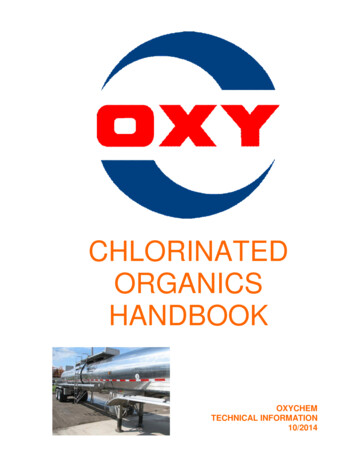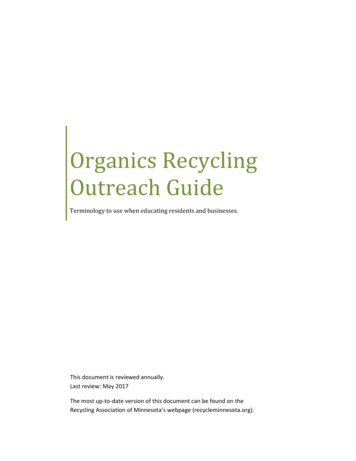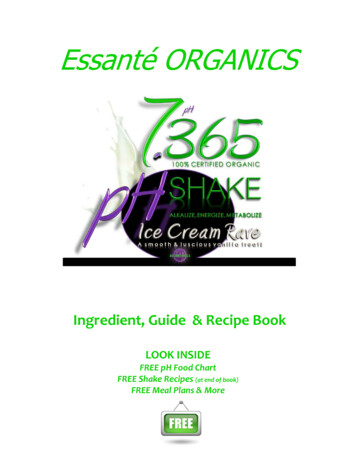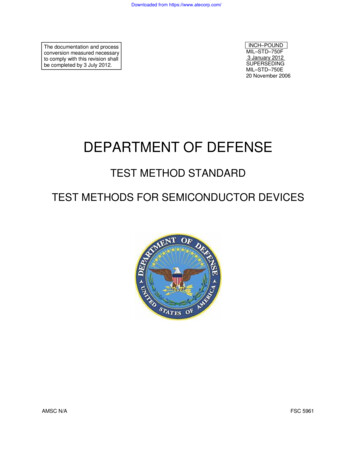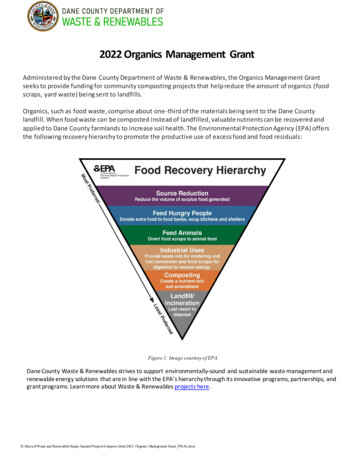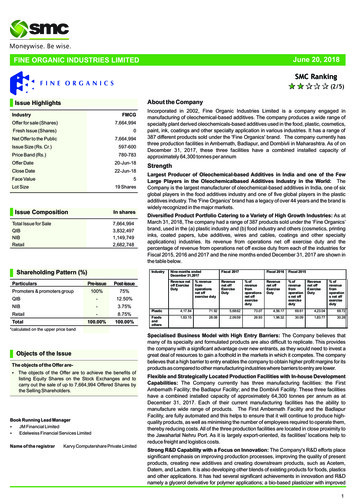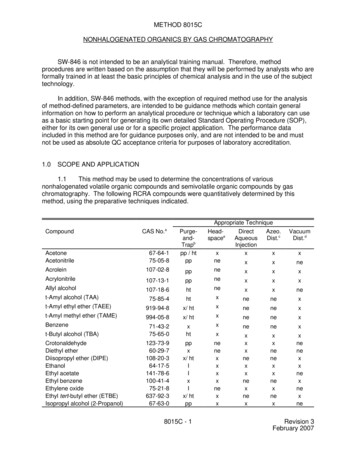
Transcription
METHOD 8015CNONHALOGENATED ORGANICS BY GAS CHROMATOGRAPHYSW-846 is not intended to be an analytical training manual. Therefore, methodprocedures are written based on the assumption that they will be performed by analysts who areformally trained in at least the basic principles of chemical analysis and in the use of the subjecttechnology.In addition, SW-846 methods, with the exception of required method use for the analysisof method-defined parameters, are intended to be guidance methods which contain generalinformation on how to perform an analytical procedure or technique which a laboratory can useas a basic starting point for generating its own detailed Standard Operating Procedure (SOP),either for its own general use or for a specific project application. The performance dataincluded in this method are for guidance purposes only, and are not intended to be and mustnot be used as absolute QC acceptance criteria for purposes of laboratory accreditation.1.0SCOPE AND APPLICATION1.1This method may be used to determine the concentrations of variousnonhalogenated volatile organic compounds and semivolatile organic compounds by gaschromatography. The following RCRA compounds were quantitatively determined by thismethod, using the preparative techniques indicated.Appropriate nitrileAllyl alcoholt-Amyl alcohol (TAA)t-Amyl ethyl ether (TAEE)t-Amyl methyl ether (TAME)Benzenet-Butyl alcohol (TBA)CrotonaldehydeDiethyl etherDiisopropyl ether (DIPE)EthanolEthyl acetateEthyl benzeneEthylene oxideEthyl tert-butyl ether (ETBE)Isopropyl alcohol (2-Propanol)aPurgeandTrapbpp / htppHeadspaceeppneppnehtnehtxx/ htxx/ -5141-78-6100-41-475-21-8637-92-367-63-0ppxx/ htIIxIx/ htppnenexxxxnexxCAS 9-94-8994-05-88015C - xnenexxnexnexxnenexxnexnexneRevision 3February 2007
Appropriate TechniqueCompoundMethanolMethyl ethyl ketone (MEK,2-Butanone)Methyl tert-butyl ether one2-Picoline1-Propanol (n-Propyl alcohol)Propionitrile (Ethyl p-XyleneabcdexhtIneppCAS x/ cal Abstract Service Registry NumberPurge-and-Trap (Methods 5030 or 5035)Azeotropic distillation (Method 5031)Vacuum distillation (Method 5032)Headspace (Method 5021)Adequate response using this techniqueMethod analyte only when purged at 80 EC (high temperature purge)Inappropriate technique for this analyteNot evaluatedPoor purging efficiency, resulting in higher limits of quantitation. Use of an alternative samplepreparative method is strongly recommended. May be amenable to purging at elevatedtemperature.1.2This method may be applicable to the analysis of other analytes, includingtriethylamine and petroleum hydrocarbons. The petroleum hydrocarbons include gasolinerange organics (GRO) and diesel range organics (DRO). The sample preparation techniquesare shown in the table below.Appropriate TechniqueCompoundaCAS No.Triethylamine121-44-8Gasoline range organics (GRO)-Diesel range organics (DRO)-aChemical Abstract Service Registry Numberx:Adequate response using this technique;I:ne: Not sInjectionxxISolventExtractionIIxInappropriate technique for this analyte;8015C - 2Revision 3February 2007
1.2.1This method was applied to the analysis of triethylamine in water samplesby direct aqueous injection onto a different GC column than is used for any other analytes.Descriptions of the GC column, temperature program, and performance data fortriethylamine are provided in this method (see Secs. 6.2.5 and 11.2.6, and Table 6).1.2.2GRO corresponds to the range of alkanes from C6 to C10 and a boilingpoint range of approximately 60 EC - 170 EC (Reference 6). DRO corresponds to therange of alkanes from C10 to C28 and a boiling point range of approximately 170 EC - 430EC (Reference 6). The quantitative analyses of these fuel types are based on theprocedures described in Sec. 11.11. The identification of specific fuel types may becomplicated by environmental processes such as evaporation, biodegradation, or whenmore than one fuel type is present. Methods from other sources may be more appropriatefor GRO and DRO, since these hydrocarbons are not regulated under RCRA. ConsultState and local regulatory authorities for any specific regulatory requirements.1.2.3This method may be applicable to classes of analytes and to fuel typesand petroleum hydrocarbons other than those listed in Secs. 1.1 and 1.2. However, inorder to be used for additional analytes, fuel types, or petroleum hydrocarbons, the analystmust demonstrate that the gas chromatographic conditions, including the GC column, areappropriate for the analytes of interest. The analyst must also perform the initialdemonstration of proficiency described in Sec. 9.4 and Method 8000. Expansion of thismethod to other fuel types or petroleum hydrocarbons will also necessitate careful definingof the boiling point range or carbon number range of the material and modification of thequantitation approach to match such ranges. Analysts are advised to consult authoritativesources, such as the American Petroleum Institute (API), for relevant definitions of otherfuel types or petroleum fractions.NOTE:Mention of the analyses of other fuel types and petroleum fractions does notimply a regulatory requirement for such analyses, using this or any othermethod.1.3This method can also be used as a screening tool (for both volatile andsemivolatile organics) to obtain semiquantitative data to prevent overloading the GC/MS systemduring quantitative analysis. This may be accomplished using a purge-and-trap method (e.g.,Method 5030), an automated headspace method (e.g., Method 5021), direct aqueous injection,or by direct injection, if a solvent extraction method has been utilized for sample preparation.Single-point calibration is acceptable in this situation. Performance data are not provided forscreening.1.4Prior to employing this method, analysts are advised to consult the base methodfor each type of procedure that may be employed in the overall analysis (e.g., Methods 3500,3600, 5000, and 8000) for additional information on quality control procedures, development ofQC acceptance criteria, calculations, and general guidance. Analysts also should consult thedisclaimer statement at the front of the manual and the information in Chapter Two for guidanceon the intended flexibility in the choice of methods, apparatus, materials, reagents, andsupplies, and on the responsibilities of the analyst for demonstrating that the techniquesemployed are appropriate for the analytes of interest, in the matrix of interest, and at the levelsof concern.In addition, analysts and data users are advised that, except where explicitly specified in aregulation, the use of SW-846 methods is not mandatory in response to Federal testing8015C - 3Revision 3February 2007
requirements. The information contained in this method is provided by EPA as guidance to beused by the analyst and the regulated community in making judgments necessary to generateresults that meet the data quality objectives for the intended application.1.5This method is restricted for use by, or under the supervision of, analystsappropriately experienced and trained in the use of a gas chromatograph and skilled in theinterpretation of gas chromatograms. In addition, if this method is to be used for the analysis ofpetroleum hydrocarbons, its use then should be limited to analysts experienced in theinterpretation of hydrocarbon data. Each analyst must demonstrate the ability to generateacceptable results with this method.2.0SUMMARY OF METHOD2.1This method provides gas chromatographic conditions for the detection of certainnonhalogenated volatile and semivolatile organic compounds.2.2Depending on the analytes of interest, samples may be introduced into the GC bya variety of techniques, including: Purge-and-trap (Methods 5030 or 5035) Equilibrium headspace (Method 5021) Direct injection of aqueous samples Injection of the concentrate from azeotropic distillation (Method 5031) Vacuum distillation (Method 5032) Following solvent extraction (Methods 3510, 3520, 3535, 3540, 3541, 3545,3546, 3550, 3560, or other appropriate technique)2.3Groundwater or surface water samples generally need to be analyzed inconjunction with Methods 5021, 5030, 5031, 5032, 3510, 3520, or other appropriate preparatorymethods to obtain the necessary lower limits of quantitation. Method 3535 (solid-phaseextraction) may also be applicable to some of the target analytes, however, this method has notbeen validated by EPA in conjunction with this determinative method.2.4Samples to be analyzed for diesel range organics may be prepared by anappropriate solvent extraction method.2.5Gasoline range organics may be introduced into the GC/FID by purge-and-trap(Methods 5030 and 5035), automated headspace (Method 5021), vacuum distillation (Method5032), or other appropriate technique.2.6Triethylamine may be analyzed by direct injection of aqueous samples. Thiscompound has not been found to be amenable to purge-and-trap techniques.8015C - 4Revision 3February 2007
2.7An appropriate column and temperature program are used in the gaschromatograph to separate the organic compounds. Detection is achieved by a flame ionizationdetector (FID).2.8This method allows the use of capillary or packed columns for the analysis andconfirmation of the non-halogenated individual analytes. The GC columns and conditions listedhave been demonstrated to provide separation of those target analytes. Other columns andconditions may be employed, provided that the analyst demonstrates adequate performance forthe intended application.2.9The quantitative analyses of GRO and DRO are based on the definitions providedin Sec. 1.2.2 and the procedures described in Sec. 11.11.2.10 Given the large number of components to be separated, fused-silica capillarycolumns are necessary for the analysis of petroleum hydrocarbons, including GRO and DRO,and are recommended for all other analytes. A capillary column is also necessary for theanalysis of triethylamine.3.0DEFINITIONSRefer to Chapter One and the manufacturer's instructions for definitions that may berelevant to this procedure.4.0INTERFERENCES4.1Solvents, reagents, glassware, and other sample processing hardware may yieldartifacts and/or interferences to sample analysis. All of these materials must be demonstratedto be free from interferences under the conditions of the analysis by analyzing method blanks.Specific selection of reagents and purification of solvents by distillation in all-glass systems maybe necessary. Refer to each method to be used for specific guidance on quality controlprocedures and to Chapter Four for general guidance on the cleaning of glassware.4.2When analyzing for volatile organics, samples can be contaminated by diffusion ofvolatile organics (particularly chlorofluorocarbons and methylene chloride) through the samplecontainer septum during shipment and storage. A trip blank prepared from organic-free reagentwater and carried through sampling and subsequent storage and handling will serve as a checkon such contamination.4.3Contamination by carryover can occur whenever high-concentration andlow-concentration samples are analyzed in sequence. To reduce the potential for carryover, thesample syringe or purging device needs to be rinsed out between samples with an appropriatesolvent. Whenever an unusually concentrated sample is encountered, it should be followed byinjection of a solvent blank to check for cross contamination.4.3.1Clean purging vessels with a detergent solution, rinse with distilled water,and then dry in a 105 EC oven between analyses. Clean syringes or autosamplers byflushing all surfaces that contact samples using appropriate solvents.8015C - 5Revision 3February 2007
4.3.2All glassware must be scrupulously cleaned. Clean all glassware as soonas possible after use by rinsing with the last solvent used. This should be followed bydetergent washing with hot water, and rinses with tap water and organic-free reagentwater. Drain the glassware and dry it in an oven at 130 EC for several hours or rinse itwith methanol and drain. Store dry glassware in a clean environment.4.4The flame ionization detector (FID) is a non-selective detector. There is a potentialfor many non-target compounds present in samples to interfere with this analysis. There is alsothe potential for analytes to be resolved poorly, especially in samples that contain manyanalytes. The data user should consider this and may wish to alter the target analyte listaccordingly.5.0SAFETYThis method does not address all safety issues associated with its use. The laboratory isresponsible for maintaining a safe work environment and a current awareness file of OSHAregulations regarding the safe handling of the chemicals listed in this method. A reference fileof material safety data sheets (MSDSs) should be available to all personnel involved in theseanalyses.6.0EQUIPMENT AND SUPPLIESThe mention of trade names or commercial products in this manual is for illustrativepurposes only, and does not constitute an EPA endorsement or exclusive recommendation foruse. The products and instrument settings cited in SW-846 methods represent those productsand settings used during method development or subsequently evaluated by the Agency.Glassware, reagents, supplies, equipment, and settings other than those listed in this manualmay be employed provided that method performance appropriate for the intended applicationhas been demonstrated and documented.This section does not list common laboratory glassware (e.g., beakers and flasks).6.1Gas chromatograph -- Analytical system equipped with gas chromatographsuitable for solvent injections, direct aqueous injection, headspace, vacuum distillation sampleintroduction, or purge-and-trap sample introduction, and equipped with all necessaryaccessories, including detectors, column supplies, recorder, gases, and syringes. A datasystem for measuring peak heights and/or peak areas is recommended.6.2Recommended GC columnsThe choice of GC column will depend on the analytes of interest, the expectedconcentrations, and the intended use of the results. The packed columns listed below aregenerally used for screening analyses. The capillary columns are necessary for petroleumhydrocarbon analyses and for triethylamine analyses and are recommended for all otheranalyses.The columns listed in this section were the columns used to develop the method. Thelisting of these columns in this method is not intended to exclude the use of other columns thatare available or that may be developed. The laboratory may use either the columns listed in this8015C - 6Revision 3February 2007
method or other columns and columns of other dimensions, provided that the laboratorydocuments method performance data (e.g., chromatographic resolution, analyte breakdown,and sensitivity) that are appropriate for the intended application.6.2.1Column 1 -- 8-ft x 0.1-in. ID stainless steel or glass column, packed with1% SP-1000 on Carbopak-B 60/80 mesh or equivalent.6.2.2Column 2 -- 6-ft x 0.1-in. ID stainless steel or glass column, packed withn-octane on Porasil-C 100/120 mesh (Durapak) or equivalent.6.2.3Column 3 -- 30-m x 0.53-mm ID fused-silica capillary column bonded withDB-Wax (or equivalent), 1-µm film thickness.6.2.4Column 4 -- 30-m x 0.53-mm ID fused-silica capillary column chemicallybonded with 5% methyl silicone (DB-5, SPB-5, RTx, or equivalent), 1.5-µm film thickness.6.2.5Column 5 -- 30-m x 0.53-mm ID fused-silica capillary column bonded withHP Basic Wax (or equivalent), 1-µm film thickness. This column is used for triethylamine.6.2.6Wide-bore columns should be installed in 1/4-inch injectors, equippedwith deactivated liners designed specifically for use with these columns.6.3Detector -- Flame ionization (FID)6.4Sample introduction and preparation apparatus6.4.1Refer to the 5000 series sample preparation methods for the appropriateapparatus for purge-and-trap, headspace, azeotropic distillation, and vacuum distillationanalyses.6.4.2Samples may also be introduced into the GC via injection of solventextracts or direct injection of aqueous samples.6.5Syringes6.5.15-mL Luer-Lok glass hypodermic and 5-mL gas-tight syringe equippedwith a shutoff valve, for volatile analytes.6.5.2Microsyringes -- 10- and 25-µL equipped with a 0.006-in. ID needle(Hamilton 702N or equivalent) and 100-µL.6.6stoppers.6.7Volumetric flasks, Class A -- Appropriate sizes equipped with ground-glassAnalytical balance -- 160-g capacity, capable of measuring to 0.0001 g.8015C - 7Revision 3February 2007
7.0REAGENTS AND STANDARDS7.1Reagent-grade chemicals must be used in all tests. Unless otherwise indicated, itis intended that all reagents conform to the specifications of the Committee on AnalyticalReagents of the American Chemical Society, where such specifications are available. Othergrades may be used, provided it is first ascertained that the reagent is of sufficiently high purityto permit its use without lessening the accuracy of the determination. Reagents should bestored in glass to prevent the leaching of contaminants from plastic containers.7.2Organic-free reagent water -- All references to water in this method refer toorganic-free reagent water, as defined in Chapter One.7.3solvents.Methanol, CH3OH, pesticide quality or equivalent -- Store away from other7.4Fuels, e.g., gasoline or diesel -- Purchase from a commercial source. Low-boilingcomponents in fuel evaporate quickly. As applicable and available, obtain the fuel from theleaking tank on site.7.5Alkane standard -- A standard containing a homologous series of n-alkanes forestablishing retention times (e.g., C10-C28 for diesel).7.6Standard solutionsThe following sections describe the preparation of stock, intermediate, and workingstandards for the compounds of interest. This discussion is provided as an example, and otherapproaches and concentrations of the target compounds may be used, as appropriate for theintended application. See Method 8000 for additional information on the preparation ofcalibration standards.7.7Stock standards -- Stock solutions may be prepared from pure standard materialsor purchased as certified solutions. When methanol is a target analyte or when usingazeotropic distillation for sample preparation, standards should not be prepared in methanol.Standards must be replaced after 6 months or sooner, if comparison with check standardsindicates a problem.7.8Secondary dilution standards -- Using stock standard solutions, prepare secondarydilution standards, as needed, that contain the compounds of interest, either singly or mixedtogether. The secondary dilution standards should be prepared at concentrations such that theaqueous calibration standards prepared in Sec. 7.9 will bracket the working range of theanalytical system. Secondary dilution standards should be stored with minimal headspace forvolatiles and should be checked frequently for signs of degradation or evaporation, especiallyjust prior to preparing calibration standards from them.7.9Calibration standards -- Prepare calibration standards at a minimum of fivedifferent concentrations in organic-free reagent water (for purge-and-trap, direct aqueousinjection, azeotropic distillation, or vacuum distillation) or in methylene chloride (for solventinjection) from the secondary dilution of the stock standards. For headspace, prepare thestandards as directed in Method 5021. One of the standards should be at or below theconcentration equivalent to the appropriate lower limit of quantitation for the project. The8015C - 8Revision 3February 2007
remaining concentrations should correspond to the expected range of concentrations found inreal samples or should define the working range of the GC. Each standard should contain eachanalyte to be determined by this method (e.g., some or all of the compounds listed in Sec. 1.1may be included). In order to prepare accurate aqueous standard solutions, the followingprecautions need to be observed:7.9.1Do not inject more than 20 µL of methanolic standards into 100 mL ofwater.7.9.2Use a 25-µL Hamilton 702N microsyringe or equivalent (variations inneedle geometry will adversely affect the ability to deliver reproducible volumes ofmethanolic standards into water).7.9.3Rapidly inject the primary standard into the filled volumetric flask.Remove the needle as fast as possible after injection.7.9.4Mix diluted standards by inverting the flask three times only.7.9.5Fill the sample syringe from the standard solution contained in theexpanded area of the flask (do not use any solution contained in the neck of the flask).7.9.6The negative pressure generated by pipettes makes them inappropriatefor routine use in the transfer of spiked solutions. As such, use of pipettes to dilute ortransfer aqueous standards should be avoided. When sample transfer is absolutelynecessary, (such as in the performance of headspace sample preparation for watersamples) only high quality, automatic pipettes should be used, and then with extremecare.7.9.7Aqueous standards used for purge-and-trap analyses (Method 5030) arenot stable and should be discarded after 1 hr, unless held in sealed vials with zeroheadspace. If so stored, they may be held for up to 24 hrs. Aqueous standards used forazeotropic distillation (Method 5031) may be stored for up to a month inpolytetrafluoroethylene (PTFE)-sealed screw-cap bottles with minimal headspace, at #6EC, and protected from light.7.9.8Standards for direct aqueous injection of triethylamine are prepared bydissolving an appropriate weight of neat triethylamine in organic-free reagent water anddiluting to volume in a volumetric flask.7.10 Internal standards (if internal standard calibration is used) -- To use this approach,the analyst needs to select one or more internal standards that are similar in analytical behaviorto the compounds of interest. The analyst needs to further demonstrate that the measurementof the internal standard is not affected by method or matrix interferences. Because of theselimitations, no internal standard can be suggested that is applicable to all samples. Thefollowing internal standards are recommended when preparing samples by azeotropicdistillation (Method 5031): 2-chloroacrylonitrile, hexafluoro-2-propanol, andhexafluoro-2-methyl-2-propanol.7.11 Surrogate standards -- Whenever possible, the analyst should monitor both theperformance of the analytical system and the effectiveness of the method in dealing with each8015C - 9Revision 3February 2007
sample matrix, by spiking each sample, standard, and blank with one or two surrogatecompounds which are not affected by method interferences.8.0SAMPLE COLLECTION, PRESERVATION, AND STORAGE8.15035.8.29.0See the introductory material to Chapter Four, "Organic Analytes," and MethodIf the headspace technique is used, also see Method 5021.QUALITY CONTROL9.1Refer to Chapter One for guidance on quality assurance (QA) and quality control(QC) protocols. When inconsistencies exist between QC guidelines, method-specific QCcriteria take precedence over both technique-specific criteria and those criteria given in ChapterOne, and technique-specific QC criteria take precedence over the criteria in Chapter One. Anyeffort involving the collection of analytical data should include development of a structured andsystematic planning document, such as a Quality Assurance Project Plan (QAPP) or a Samplingand Analysis Plan (SAP), which translates project objectives and specifications into directionsfor those that will implement the project and assess the results. Each laboratory shouldmaintain a formal quality assurance program. The laboratory should also maintain records todocument the quality of the data generated. All data sheets and quality control data should bemaintained for reference or inspection.9.2Refer to Method 8000 for specific determinative method QC procedures. Refer toMethods 3500 and 5000 for QC procedures to ensure the proper operation of the varioussample preparation and/or sample introduction techniques. If an extract cleanup procedure isperformed, refer to Method 3600 for the appropriate QC procedures. Any more specific QCprocedures provided in this method will supersede those noted in Methods 8000, 3500, 5000, or3600.9.3Quality control procedures necessary to evaluate the GC system operation arefound in Method 8000 and include evaluation of retention time windows, calibration verificationand chromatographic analysis of samples.9.4Initial demonstration of proficiencyEach laboratory must demonstrate initial proficiency with each sample preparation anddeterminative method combination it utilizes, by generating data of acceptable accuracy andprecision for target analytes in a clean matrix. If an autosampler is used to perform sampledilutions, before using the autosampler to dilute samples, the laboratory should satisfy itself thatthose dilutions are of equivalent or better accuracy than is achieved by an experienced analystperforming manual dilutions. The laboratory must also repeat the demonstration of proficiencywhenever new staff members are trained or significant changes in instrumentation are made.See Methods 5000 and 8000 for information on how to accomplish a demonstration ofproficiency.8015C - 10Revision 3February 2007
9.5Initially, before processing any samples, the analyst should demonstrate that allparts of the equipment in contact with the sample and reagents are interference-free. This isaccomplished through the analysis of a method blank. As a continuing check, each timesamples are extracted, cleaned up, and analyzed, and when there is a change in reagents, amethod blank should be prepared and analyzed for the compounds of interest as a safeguardagainst chronic laboratory contamination. If a peak is observed within the retention time windowof any analyte that would prevent the determination of that analyte, determine the source andeliminate it, if possible, before processing the samples. The blanks should be carried throughall stages of sample preparation and analysis. When new reagents or chemicals are received,the laboratory should monitor the preparation and/or analysis blanks associated with samplesfor any signs of contamination. It is not necessary to test every new batch of reagents orchemicals prior to sample preparation if the source shows no prior problems. However, ifreagents are changed during a preparation batch, separate blanks need to be prepared for eachset of reagents.9.6Sample quality control for preparation and analysisThe laboratory must also have procedures for documenting the effect of the matrix onmethod performance (precision, accuracy, method sensitivity). At a minimum, this shouldinclude the analysis of QC samples including a method blank, a matrix spike, a duplicate, and alaboratory control sample (LCS) in each analytical batch and the addition of surrogates to eachfield sample and QC sample when surrogates are used. Any method blanks, matrix spikesamples, and replicate samples should be subjected to the same analytical procedures (Sec.11.0) as those used on actual samples.9.6.1Documenting the effect of the matrix should include the analysis of atleast one matrix spike and one duplicate unspiked sample or one matrix spike/matrix spikeduplicate pair. The decision on whether to prepare and analyze duplicate samples or amatrix spike/matrix spike duplicate must be based on a knowledge of the samples in thesample batch. If samples are expected to contain target analytes, then laboratories mayuse one matrix spike and a duplicate analysis of an unspiked field sample. If samples arenot expected to contain target analytes, laboratories should use a matrix spike and matrixspike duplicate pair. Consult Method 8000 for information on developing acceptancecriteria for the MS/MSD.9.6.2A laboratory control sample (LCS) should be included with each analyticalbatch. The LCS consists of an aliquot of a clean (control) matrix similar to the samplematrix and of the same weight or volume. The LCS is spiked with the same analytes atthe same concentrations as the matrix spike, when appropriate. When the results of thematrix spike analysis indicate a potential problem due to the sample matrix itself, the LCSresults are used to verify that the laboratory can perform the analysis in a clean matrix.Consult Method 8000 for information on developing acceptance criteria for the LCS.9.6.3Also see Method 8000 for details on carrying out sample quality controlprocedures for preparation and analysis. In-house method performance criteria forevaluating method performance should be developed using the guidance found in Method8000.8015C - 11Revision 3February 2007
9.7Surrogate recoveriesIf surrogates are used, the laboratory should evaluate surrogate recovery data fromindividual samples versus the surrogate control limits developed by the laboratory. See Method8000 for information on evaluating surrogate data and developing and updating surrogate limits.Procedures for evaluating the recoveries of multiple surrogates and the associated correctiveactions should be defined in an approved project plan.9.8.It is recommended that the laboratory adopt additional quality assurance practicesfor use with this method. The specific practices that are most productive depend upo
2.4 Samples to be analyzed for diesel range organics may be prepared by an appropriate solvent extraction method. 2.5 Gasoline range organics may be introduced into the GC/FID by purge-and-trap (Methods 5030 and 5035), automated headspace (Method 5021), vacuum distillation (Method 5032), or other appropriate technique.
